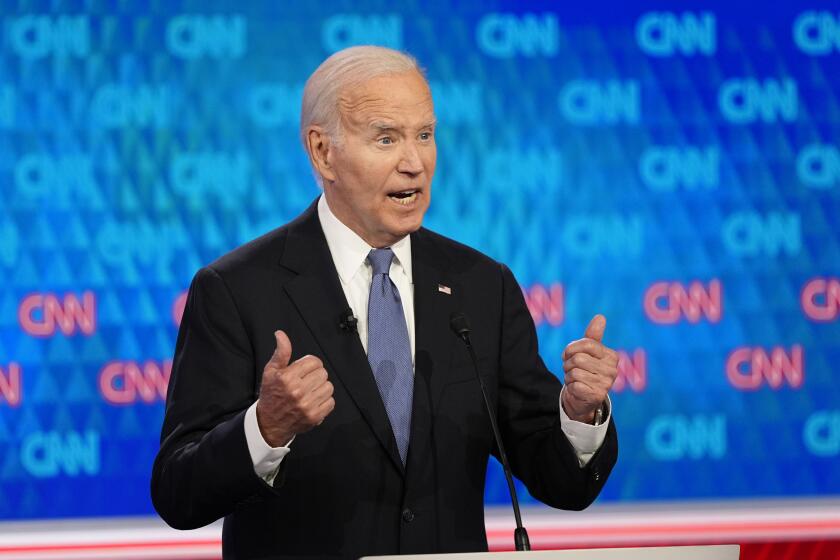Rapid-Paced Turtle Sales Starting to Slow Down : Toys: Rival manufacturers see a cooling of the ‘Ninja’ fad as a chance to regain a larger share of the market.
After what must seem like an eternity to weary parents and sales-starved makers of rival toys, Teenage Mutant Ninja Turtle mania is cooling.
Sales of that gang of four pizza-chomping sewer dwellers--a whopping total of about $1.1 billion at retail over the past four years--dropped by about one-third this year, and analysts expect sales to taper off even more in 1992.
Coupled with the declining video game craze, the passing of the Turtle fad--which at its peak in 1990 represented nearly 60% of all movable toy characters sold in the United States--is sure to touch off a mad scramble among toy manufacturers for their share of the newly freed toy market.
Toy makers couldn’t be happier. “It’s go for broke time,” one said. “Everyone will be fighting to replace Teenage Mutant Ninja Turtles.”
Meanwhile, Playmates Toys, the La Mirada distributor of the awesome foursome, will be fighting its own battle: to turn its colossal hit from a one-time fad into a timeless classic such as G.I. Joe, who still does a steady and handsome business 27 years after being deployed.
“We recognize that nothing goes on forever,” said Richard Sallis, Playmates Toys’ president. “But we’re entering our fifth year, and if you get to five years, there’s probably no reason you can’t grow to 10. The trick is in managing it.”
It’s a mean trick that few toy companies have been able to pull off. In fact, toy industry mega-hits are equally likely to pull down their makers when they cool. When Teddy Ruxpin, the talking teddy bear that was a huge success in the mid-1980s, crashed, so did Worlds of Wonder. Coleco folded when Cabbage Patch dolls went from red-hot to lukewarm. And Atari was never the same after the first video game craze ended nearly a decade ago.
Only Barbie, who turned 32 this year, G.I. Joe and a handful of cartoon characters such as Mickey Mouse and Snoopy have managed to remain perennial favorites among successive waves of youngsters.
Although it remains unclear whether Leonardo, Michelangelo, Donatello and Raphael--as the four Turtles are named--have what it takes to become one of these timeless classics, their initial sales performance has been indisputably the best ever for toy characters.
Since their introduction in 1988, about $850 million worth of Turtle toy merchandise--not including clothing and other licensed items--has been sold at wholesale, the equivalent of about $1.1 billion at retail prices. The total is enough to make the Turtles, in just four years, one of the three top-selling toy figures ever, along with G.I. Joe and the “Star Wars” characters.
Hits are important to the overall toy industry, because they get children and parents into toy stores and in a spending mood. But rival toy manufacturers get edgy if a hit is too big, because it smothers the competition.
“I’m delighted that the peak has been passed and Turtles are on their way down,” said Dave Mauer, president of Mattel USA. “If the Turtles crash and burn, that plays into our hands. Those dollars have to go somewhere.”
But any obituaries for the Turtles are decidedly premature. Despite their cooling, analysts still expect Turtle merchandise sales to reach at least $200 million next year--down from $300 million in 1991--and to remain the top-selling character toy among boys, just as they have been for the past two years.
“Turtles can still have a 50% decline in sales next year and be twice as large as anything out there,” noted John Taylor, a toy analyst for L. H. Alton, a San Francisco brokerage. “The growth may be gone, but this thing has a long way to run.”
But now that the mania that has gripped the 5-year-old to 10-year-old set for the past four years appears to have been broken, it has created an opening for a new fad to take its place. And the toy companies, some of which held back introducing new products during the past two years for fear their efforts would be futile against the Turtles, are expected to throw their best stuff into the heated competition for the next big hit.
Although most toy companies are keeping tight wraps on their products until their official unveiling at Toy Fair next February in New York, rumors abound throughout Toy Land.
Hasbro, it is said, will introduce “Rockin Rollin Miner Ants,” a set of six humanoid insect figures unveiled in the same comic book that introduced the Turtles. Whiz, Crash, TNT, Rockin, Figure and Queenie (the leader of the pack) live in a coal mine and like rock music. They get around on roller skates. Hasbro is also said to be introducing a James Bond Jr. set of action figures.
Tyco is widely expected to unveil “Crash Dummies,” figures patterned after the Department of Transportation’s test-car dummies that spew body parts if they’re not wearing safety belts when children crash their cars into walls.
Kenner is said to be counting on figures from the upcoming “Batman II” movie, and Galoob is rumored to have a set of collectible figures called “Trashbag Bunch” ready to ship. Industry sources also say that Tiger Toys will introduce “Battle Toads.”
So far, Mattel is publicly hitching its star to figures from the new “Hook” movie, as well as a series of characters from “American Gladiators,” the hot new television sporting event whose musclemen and women have names like Gemini, Turbo and Nitro. But industry insiders figure Mattel may be ready to launch a product created under its ongoing development deal with Lucasfilm. Mattel’s Mauer isn’t saying.
Meanwhile, Playmates’ Sallis professed to be unconcerned about the stepped-up competition. He said he hasn’t seen or heard of anything “that scares me . . . I just don’t see anything that will take our business away.”
For its part, Playmates will introduce 45 to 50 new Turtle characters and 20 accessories next year, about the same level of new merchandise rolled out this year. There will also be at least five new incarnations of the basic four Turtles.
In the wake of noticeably slowing Turtle sales in recent weeks, Sallis said his company is holding back Turtle shipments to prevent a glut of old, stale inventory on toy store shelves taking up the valuable space that would otherwise go to new merchandise.
“Playmates is very smart,” said Sean McGowan, of Gerard Klauer Mattison, a New York brokerage. “I have never seen a toy company manage a boom product so well.”
Although Playmates burst into the national consciousness with Teenage Mutant Ninja Turtles, the company has been around since 1966, when it started as a Hong Kong manufacturer of toys for other companies.
The Turtles, which were brought out in 1988, were picked up by Playmates only after every other U.S. toy maker turned down the concept, saying that their names were too long, the characters were too gross and the whole notion of four New York teen-agers who had been turned into sewer-dwelling, crime-fighting turtles was mind-boggling and bizarre.
But now Sallis argues that the Turtles are well on their way to becoming one of the toy industry’s perennial staples. The only question, he said, is what level of sales they can generate year after year.
“We have to watch the numbers and inventory so we don’t implode,” Sallis said. “But after that, I feel that every toy has a cycle. Is it one year, or is it 50 years? After five years . . . we’re half way to G.I. Joe status.”
Cowabunga, Dude! Turtle Power’s on the Wane
After years of phenomenal sales growth, the popularity of Leonardo, Donatello, Raphael and Michelangelo is on the wane. But Playmates Toys still believes the awesome foursome has enough staying power to join Barbie and G.I. Joe in the pantheon of classic toys. Sales of Teenage Mutant Ninja Turtle figures and toy accessories: (wholesale sales, U.S. only):
1988: $23 million
1989: $115 million
1990: $400 million
1991, estimated: $300 million
Source: Playmates Toys
Sales of all action-toy figures and accessories in U.S. (at wholesale):
1988: $523 million
1989: $553 million
1990: $685 million
1991, estimated: $650 million
Source: Toy Manufacturers of America and L.H. Alton & Co.






